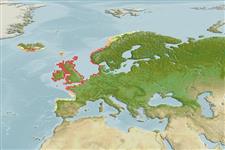Common names from other countries
Classification / Names / Names
Nama-nama umum | Sinonim (persamaan) | Catalog of Fishes (gen., sp.) | ITIS | CoL | WoRMS
Environment: milieu / climate zone / depth range / distribution range
Ekologi
; payau; kisaran kedalaman 7 - 9 m (Ref. 2851). Temperate
Northeast Atlantic: Europe.
Length at first maturity / Size / Weight / umur
Maturity: Lm ? range ? - ? cmUmur maksimum dilaporkan: 1.00 Tahun (Ref. 130103)
Depth based on occurrence (Ref. 2851, p. 719); to be replaced with better reference. Life span is less than 1 yr (Ref. 130103). Found in estuarine and inshore areas in silt to very fine sand substrate. A microvore that feeds on organic detritus (Ref. 96352).
Members of the order Cumacea are gonochoric and sexually dimorphic. Spawning is characterized by nocturnal swarming behavior. Females brood the eggs in the marsupium where they molt, become mancas and leave.
rujukan utama
Acuan | Koordinator | mitra
Alves, F., L. Chicharo, A. Nogueira and J. Regala. 2003. (Ref. 2851)
Status IUCN Red List (Ref. 130435)
status CITES (Ref. 108899)
Not Evaluated
Not Evaluated
penggunaan manusia
| FishSource |
Alat, peralatan
informasi lanjut
Umur / SaizPertumbuhanpanjang-beratpanjang-panjangMorfologiLarvaKelimpahan
Sumber internet
Estimates based on models
Preferred temperature
(Ref.
115969): 8.9 - 12.5, mean 10.7 (based on 314 cells).
Daya lenting
Tinggi, Waktu penggandaan populasi minimum kurang dari 15 bulan (tmax<1).
kategori harga
Unknown.
